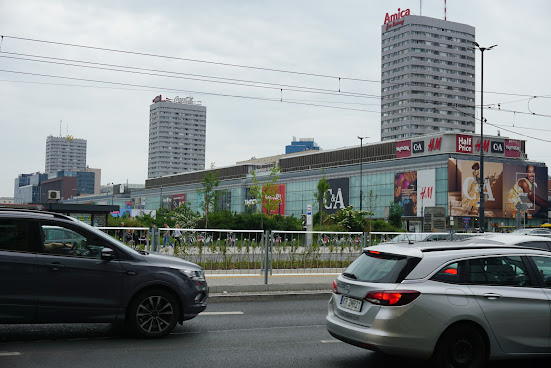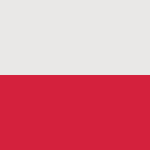Metro Centrum
#Warsaw tour guide #Warsaw city guide # guided tour in warsaw #Warszawa tour guide #Warszawa city guide #guided tour in Warszawa
The Centre in Warsaw is defined by the Palace of Culture, and right here, just a few hundred metres from each other, we find Metro Centrum, the local station Warszawa Śródmieście, Warszawa Centralna (which is the actual central station), the local station Warszawa Ochota and Warszawa Główna (which translates to Central station, but is in reality a minor station).
Maybe Metro Centrum is the best place to start your visit, and this will happen automatically if you stay at one of the large hotels surrounding the Palace of Culture.
Close up
The Palace of Culture (Pałac kultury i nauki)

In front of the main entrance you find the Parade Square (Plac Defilad), which was indented for huge pro government manifestations and May 1st parades during the communist ara.
The Palace of Culture is a symbol of Soviet domination in Poland, and also a tale about Warsaw and the history of the city. The actual building and the surroundings is a must, when you visit Warsaw. If you take the lift to the Viewing Terrace, you will get a fabulous impression of the city, whereas the walk around the building will leave you with an idea of the modern history of the city. If you like long walks, a tour around the building will make you feel its proportions and also you will enjoy the many details offered by the low-rise extensions. Bygningen og omgivende område er et must, når man besøger Warszawa. En tur til udsigtsterrassen giver et fantastisk indtryk af byen, mens turen rundt om bygningen giver et godt indtryk af byens nyere historie. Hvis man kan lide at spadsere er det en ide at gå en tur rundt om hele bygningen for ligesom at føle dens proportioner og nyde de mange detaljer, de lave tilbygninger tilbyder.

The place where Piotr Szczęsny committed self-immolation.
By the wall next to the tribune we notice a commemorative plaque for Piotr Szczęsny, who in October 2017 set himself on fire and died wile protesting against the government’s restrictions of democratic freedoms and the violation of the Polish Constitution.
The skyscrapers

Zlota 44 in the middle with a shape that can remind you of a ship
However, the Palace of Culture’s position as a symbol of Warsaw is challenged by the surrounding high-rise buildings, which seem to try to explain the superiority of capitalism in relation to socialism. They all have interesting characteristics, but one of my favourites is the apartment complex Zlota 44, which is also called “the sail” because of its shape.
Aleje Jerolimskie (Jerusalem Avenue) in front of the Palace of Culture.

Hotel Novotel Centrum. A 33-storey hotel from 1972 located diagonally opposite the metro. Originally it was yellow, but has been modernized and had the front renovated a few years ago. The yellowish building is the hotel Polonia Palace, which is located in a pre-war building.
A line of beautiful buildings from before WWII, Among others the exquisite Hotel Polonia Palace. The old buildings are kind of framed by the Marriott hotel and office complex. The 42 storeys were completed in 1989 as the first “modern” building in Warsaw, and predicted somewhat menacingly that the position of the Palace of Culture could one day be threatened. A legendary bar with city views from the top floor. However, the entire row of buildings is best observed from the Viewing Terrace of the Palace of Culture.
Dworzec Centralny (Central station).

Dworzec Centralny (the Central Station) next to the shopping mall Złote Tarasy (the Golden Terraces) with its undulating glassy roof.
Recently modernized, but retains its characteristic shape from the 1970s. It stands in the middle between two busy streets, a bit like an island in the middle of a heap of traffic. All train traffic runs underground, which is full of tunnels with a vibrant and slightly chaotic life and lots of small shops. The above-ground railway station is a late modernist and functional building with a huge and expressive roof structure. Next to it is the bus station, and along the main streets there are plenty of trams The shopping mall Złote terasy (the Golden Terraces). Right next to the Central Station. A huge modern shopping centre, with all the international shops your Visa card may desire. Lots of fast food restaurants and a cinema on the top floor. At the ground floor we also find a number of bars and restaurants, including the Hard Rock Cafe.

The Eastern Wall – framing the Palace of Culture. Marszałkowska Street.
The Eastern Wall is right opposite to the Palace of Culture, which somehow lies in the middle of a large open – or empty – terrain. This is about to change, though. Originally, a pompous row of palace-like buildings opposite the Palace of Culture was planned, but it was never implemented, partly because Stalin died, and with him all his architectural visions.

Parts of the Eastern Wall – the shopping centre flanked by high-rise concrete buildings
In stead a number of lower high-rise buildings were built in a short distance from the main road, which were to form a kind of frame around the area and the Palace of Culture. They may not be specially pretty, but Novotel is definitely more impressive after a thorough renovation a few years ago. In between these buildings were placed a series of low shopping centres and a rotunda, which housed a branch of one of Poland’s major banks. The rotunda has now been demolished and rebuilt, which could also be done to a number of the other 1960s buildings. But in a way, it is an interesting construction. In front of the shopping centres, a wide half-roof forms a kind of boulevard, and at the back you will find a cozy urban environment. From a historical perspective, it is worth noting that the Eastern Wall marks the end of Stalin’s Socialist Realist architecture, and the beginning of a search for a new way of architectural expression.
Walk number 1. Metro – Poznańska street– Piękna – Konstytucja square– Marszałkowska – Metro.

Poznanska Street – here with the old telephone office, where they advertise long distance calls, telegraphy and radio telegraphy
The walk through Poznańska street will show you a lot of the architecture that survived the second world war. The trip starts from the elegant Hotel Polonia Palace, and if we’re lucky, we may pass Warsaw’s last street prostitutes on the first street corner, if it is early in the evening. There are a couple of elderly ladies with a certain directness in their vocabulary, but they evoke memories of a time when the street was known for this particular profession.

The district town hall for Midtown
On the same corner stands the renovated pre-war building that provide space for the district town hall, and on the opposite side the telephone and telegraph agency with a solid inscription on the front announcing, that telegraphs and long-distance calls can be made here, something that until the end of the 1990’s wasn’t that easy in Poland. After this, it continues with one more or less well-maintained old buildings after another plus a multitude of restaurants and bars. This is where to eat and drink instead of on the main roads.

The street is full of bars and restaurants – Here Beirut, which is surrounded by other great places

Marszałkowska street was made with the aim of being the main street for huge communist parades.
When the street ends, turn left onto Koszykowa Street, enjoy Constitution Square, featured under “Communism in Warsaw”, then head back to the metro through Marszałkowska street, while enjoying the monumental socialist buildings and the wide boulevard, which was Stalin’s prestige project, intended for large parades.

Walking in the city – No. one through Poznanska street. No. two through Nowogrodzka
Walk number 2. Metro – Nowogrodzka – Mysia – De Gaulle Roundabout– Jerozolimskie Avenue – Metro.

Nowogrodzka street is characterized by an incredible amount of restaurants and bars with craft beer
Turn left to Nowogrodzka street right next to Hotel Novotel. It will take you into a street which is a wonderful mix of modern facilities and old buildings, as well as an abundance of small bars and restaurants. Here you will find a few of Warsaw’s craft beer bars, and especially on weekends the atmosphere is really good.

The White House – a perfect place to admire the architecture of communism and the beer of capitalism
After Mysia Street, turn left on Nowy Świat, and you will arrive to one of Warsaw’s most expensive areas. The De Gaulle Roundabout containing the (communist) Party Building or White House is a huge modernist building from 1952, which until 1989 was the headquarters of the Communist Party’s powerful Central Committee. The White House also includes a number of bars with craft beer.
This is where the planners and policy-makers worked until 1989 in a building which clearly shows, where the power belongs. You enter the courtyard through two gates, and the enormous open space is designed to accommodate a large number of party members, who could listen to speeches from the leaders standing on the large balcony. The building included everything needed for political schooling, including a cinema and large meeting rooms.
For a period after the upheavals in 1989, the building was used as the stock exchange, but today a new beautiful stock exchange has been built at the back of the White House. Later, the Ministry of Agriculture had various offices in the building, which today are rented out for offices and conferences. On the ground floor, however, there are a number of bars with craft beer, which in the summer occupy a good part of the square in front of the building as well as the entire courtyard. An ideal opportunity to combine beer drinking with reflections on the architecture of power.
Next to the White House are the enormous buildings of the National Museum, and if you don’t want to see the museum inside, the return trip to the Metro is via the busy business street, Jerozolimskie.

Jerusalem Avenue

The National Museum
The National Museum at the left side of the White House and a little further towards the river the Polish Army Museum, which is a great place if you like old aircrafts.

Various equipment retired from active service is exhibited at the Polish Army Museum. Admission to the outdoor part of the exhibition is free of charge.
Please send an email to m@hardenfelt.pl if you would like an English-speaking tour guide to show you the most important places in Warsaw.
